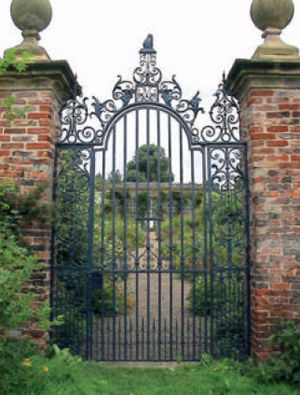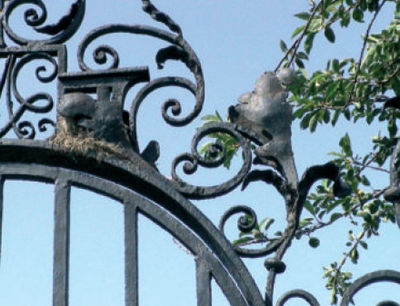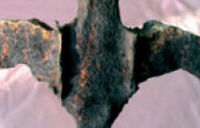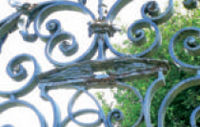Restoration of Antique Wrought Ironwork
Don Barker
The restoration of ironwork involves the repair or re-instatement of corroded or damaged components as distinct from ‘preservation’ which involves the arrest of corrosion and the maintenance of the article in its current state. The latter is normally only carried out on museum quality ironwork and is not covered in this article. Restoration work is normally carried out by skilled blacksmiths, many of whom specialise in this field of blacksmithing. The first part of this article describes the metals most commonly used by restorers followed by a description of the problems they are most likely to encounter and some of the techniques and processes used. Lastly, contributions by three different practitioners are provided to illustrate individual approaches to ironwork restoration.
A SYNOPSIS OF THE VARIOUS TYPES OF WROUGHT IRON
Historic wrought ironwork is likely to be made of either ‘charcoal iron’ which was produced until the late 18th century or, more commonly, ‘puddled iron’ which was invented by Henry Cort in 1784 and continued in production for nearly 200 years. Although both materials are intrinsically the same, they were produced using different methods and varied greatly in standards of quality.
 |
||
| A gate by Warren, the renowned late 17th century blacksmith, which has been completely restored with a minimum of intervention. |
Charcoal iron: so called because it was produced by smelting iron ore in a furnace fuelled by charcoal. The charcoal furnace could only achieve a temperature of around 700ºC at which temperature the iron coalesces into a solid sponge-like mass (bloom) containing a large amount of siliceous impurities known as ‘slag’ but no carbon. The bloom was repeatedly re-heated and hammered to remove most of the molten slag. This process left the charcoal iron with a slag content of around two percent distributed in fine layers or laminae. A small amount of carbon, typically 0.2 percent was introduced to harden the iron and make it more serviceable.
Puddled iron: by the end of the 18th century a new, much cheaper method of making wrought iron from pig iron had been developed. The pig iron was produced in coke furnaces which could reach 1,200ºC, the so-called eutectic point where the iron, having become saturated with carbon (around 3.5 percent) becomes liquid and can be tapped from the furnace. The molten iron was stirred with rods (puddled) and passed between rollers enabling one ton of pig iron to be converted to puddle iron in just 45 minutes.
The quality of puddled iron varied enormously and remained largely unregulated until the introduction in 1910 of British Standard 51, introduced specifically for the testing and certifying of new wrought iron for railway purposes. In 1939 this standard was extended to include wrought iron for general engineering purposes (Grades A, B and C) and in 1959 a further grade was added (Grade D) specifically for fencing. The cold bend test for Grade A required that a bar should be capable of being bent double over a former of the same size without showing signs of fracture on the outside of the bend. The same test for Grade D wrought iron required a bend of only 90º over a former twice the thickness of the bar being tested.
The production of new wrought iron in the UK ceased in the 1970s due to the continuing decline in demand brought about by the introduction of mild steel.
CHOICE OF MATERIAL FOR RESTORATION WORK
For the restoration and repair of historic wrought iron work it may be possible to use old wrought iron salvaged from scrap metal or modern alternatives, which include mild steel, stainless steel or pure iron.
Architectural and industrial salvage can provide a useful source of re-usable wrought iron if the source is known and the provenance good. There was a huge variation in the quality of puddled iron as demonstrated by BS 51, but all grades of puddled iron and charcoal iron are covered by the generic term ‘wrought iron’. For this reason it is important to know the source of the salvaged wrought iron. For example, redundant ships’ anchor chains were produced from high grade iron and can be used successfully as billets for re-rolling. However, lower grade wrought iron such as that used for fencing and gates is far more likely to split or crack unexpectedly when forged, particularly if the laminations have become disrupted during piecing and re-rolling.
Mild steel, the material which gradually superseded wrought iron, is used for the majority of new ‘wrought ironwork’ created by artist blacksmiths today. Due to the higher carbon content which gives it the strength for which it is renowned, mild steel requires more effort to forge than either wrought iron or pure iron.
Pure iron is produced today by Corus in England in electric arc furnaces which are capable of reaching 1900ºC. At this temperature the pure iron becomes liquid and can be tapped from the furnace. Its primary use is in the manufacture of special steels and the pharmaceutical industry but it is also available for use by blacksmiths as an alternative to mild steel or wrought iron. Like mild steel it is a homogenous material having no laminations. It is 99.8 percent pure iron. Chemically, it is very similar to charcoal iron but without the two percent slag content. Other, perhaps more familiar names for similar pure irons are Swedish iron, butter iron and Armco iron developed in 1900 by the American Rolling Mill Company for its high resistance to corrosion.
Stainless steel, a steel alloy containing at least 10.5 percent chromium, is widely used where corrosion-resistance is most important. For example, the balance shaft, spider and armature which support the lamb weather vane on Halifax Town Hall have been replaced in stainless steel following a local emergency when the original wrought iron shaft rotted away.
Galvanic compatibility is an important consideration when using stainless steel in contact with other metals such as wrought iron and mild steel. Without proper protection of the surfaces electrochemical reactions between the two metals can cause accelerated corrosion.
Among the criteria which may be considered when choosing which type of iron or steel to use for restoration and repair work are durability, price, corrosion resistance, strength, ease of working, compatibility with other adjacent materials and availability. This choice is necessarily subjective but it should be noted by the specifier that the surface finish and crispness of design achieved in the finished work will be dependant on the skill of the blacksmith and not the choice of material. The differences between them are essentially metallurgical and not visual or functional.
DAMAGE AND COMMONLY ENCOUNTERED PROBLEMS
The most commonly encountered problems facing the restorer are loss of material or components through corrosion, impact damage (usually vehicular), and previous, poorly executed repairs.
Wrought iron consists of fine layers of iron interspersed with siliceous slags giving it its characteristic grain. When paint finishes are not properly maintained and the bare metal is exposed to the atmosphere, moisture can penetrate between the layers through capillary action and oxidisation occurs. This causes expansion of the material to many times its original size, the layers being pushed apart with such force that the rusting iron can break masonry into which it is fixed. Severe corrosion will result in continuous loss of material until only a thin waist of material is left and eventually none at all.
Ironwork which has suffered impact damage can often be straightened relatively easily but many owners take the opportunity to have restoration work carried out whilst the ironwork is in the blacksmith’s shop. Old photographs of the ironwork can be a valuable reference where the damage is extensive and particularly where components are missing.
Inappropriate previous work often includes unsightly arc welded repairs and clumsy alterations to a site specific piece to adapt it to another location. Leafwork was often stripped from ornate ironwork as these are the first components to corrode. They are also the most expensive to replace. Much research work may be necessary if missing leafwork is to be re-instated
 |
|||
| The leaves which have been added to this gate during a previous restoration are extremely poor and will have to be replaced. | |||
|
|||
| The original wrought iron bars on this church cross have corroded away leaving the fire-welds standing proud. This is probably because pure iron, which is more resistant to corrosion, has been formed at the joins by the fire-welding process. The de-lamination of the central piece of wrought iron has caused jacking of the surrounding components and distortion of all adjacent components. |
| PERSONAL APPROACHES TO RESTORATION |
Don Barker The restoration of wrought ironwork raises many contentious issues, the answers to which are necessarily subjective and must be agreed with the client and the specifier and any funding body which may be contributing to the project, prior to any work being done. Firstly and most importantly is 'What do they expect the finished result to be?'. Issues to consider are the degree of intervention, what to do about previous repair work, how the existing paint should be removed and what techniques and processes should be used. There are no definitive answers to any of these questions but an experienced specialist blacksmith will always be able to guide the specifier to an informed decision by drawing on his or her wealth of knowledge built up over years of practice. My preferred material is pure iron because it has similar forging attributes to new wrought iron and yet fulfils the requirement to ensure that new work is distinguishable from the original wrought iron by any future restorer. For replacement of leafwork I use pure iron sheet laser-cut from a computer-generated image, then I shape it using traditional repoussé techniques. This demonstrates the value to be gained by the marriage of modern technology with ancient techniques. The restoration of wrought ironwork is a commercial undertaking which must be economically viable if young blacksmiths are to be encouraged to take on this type of work and preserve our valuable heritage of wrought ironwork for future generations to enjoy. |
Russel Turner There is often a difficult decision making process to be undertaken when conserving or restoring outdoor ironwork. Much exterior ironwork performs a practical function and, whether conserved or restored, it needs to be structurally adequate to fulfil its intended purpose. The ceaseless corrosion of iron unless protected from oxygen and water must also be considered to ensure works carried out will perform for the required design period. Inevitably this tends to apply pressure to consider more interventionist treatment than would be preferred if looking only at conserving an object, maintaining the maximum amount of original material, using minimum intervention techniques and not replicating missing elementss. I consider cleaning exterior metalwork, including that trapped between components, to SA 2.5 (that is to ‘near white metal’, see ISO 8501-1: 1988) to remove all rust prior to application of a new high quality paint system. This is often an acceptable and desirable compromise between maintaining the maximum amount of original material and making the paint system fit for purpose. If part of an item has corroded to such an extent as to be structurally inadequate, it must be replaced to allow the item to be useable. Replacing corroded ironwork with pure iron can be a highly appropriate choice of material for components in gates, railings and ornamental ironwork. Its chemical composition is similar to that of wrought iron, keeping any galvanic considerations to a minimum. It is also readily available and has an appropriate British Standard. As time goes on I find high quality recycled wrought iron becomes increasingly difficult to obtain. Pure iron’s workability is similar to that of wrought iron and I have found that where electric or gas welding is required, the welds obtained can be of a higher quality than welding wrought iron to wrought. It can be difficult or impossible to fire weld some repairs in situ without large scale dismantling of an object. Again there is a compromise between the amount of intervention and use of traditional techniques. The conservation/restoration of wrought ironwork will always be a lively topic of debate. Others have different approaches and opinions about cleaning and choice of materials. What seems clear to me is that pure iron is an appropriate material for restoration works and should be offered to clients where appropriate. That is not to say that recycled wrought iron has no place. On the contrary, this too is an appropriate material and it has a long track record. Most important of all is for practitioners to make the many options available to clients clear, to provide balanced advice to allow them to be involved in making informed choices relating to their objects and our heritage. Russel Turner ACR is a director of Eura Conservation and has spent over 20 years working in metal conservation. He is a former chair of UKIC Metals Section and served on the UKIC Professional Committee. |
| Richard Quinnell |
My policy on restoration can be summarised in four main objectives:
I believe that our whole purpose in restoring exterior functional ironwork is to put it back visually and functionally as closely as possible to its original state in a way that we feel the original maker, could we resurrect and consult him, would approve of, at a cost that the owner can be persuaded to afford. The professional ethics of restoration require that everything done to repair an object should, in principle, be reversible. (This is because of the dreadful mistakes made in the past which cannot now be undone). In addition, replacement material, while fully fit for its purpose, should be distinguishable from the original material. In my own practice, unless overruled by the client, I use mild steel for all replacements of wrought iron of whatever period. A competent smith can reproduce any detail originally made in wrought iron to exactly the same appearance in mild steel, using exactly the same techniques, including any type of forge-welding. Metallographic tests could then be used to distinguish between what is original and what is replacement if required in the future. Richard Quinnell MBE CWCB is a Freeman and Companion of the Worshipful Company of Blacksmiths and was awarded his MBE for services to blacksmithing. When he was first entrusted with the restoration of important historic ironwork in the 1960s there were no accepted ethical rules to guide him. However, he soon gained respect in his field and in the 1980s he served for 2 years on the Conservation Committee of the Crafts Council. His unrivalled catalogue of prestigious commissions in restoration includes Wren’s eight transept grilles at St Paul’s Cathedral in London. |





